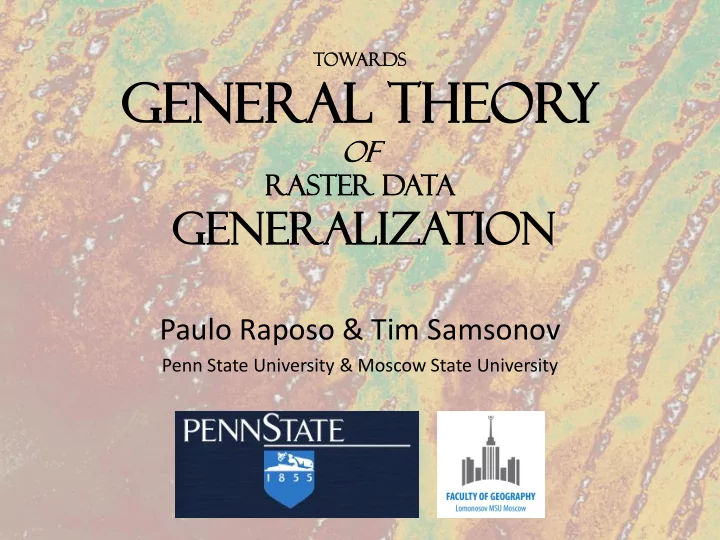

Towar ards ds Ge General neral Th Theo eor y y of of Ras aste ter r Data Ge Generaliza neralization tion Paulo Raposo & Tim Samsonov Penn State University & Moscow State University
Simple data format, but… assignment ambiguity & MAUP ≠ ≠ ≠
2 processes Cell value recalculation Cell scaling and resampling
Framework for raster generalization • Need a useful paradigm for geographical raster generalization • Specialized thematic maps can’t just use resampled and averaged rasters e.g., climatology, oceanography, social science, vector fields, etc.
Frameworks Cartography: • McMaster & Monmonier 1989 • Li et al. 2001 • Peuquet 1979 • … also much DEM generalization work Computer Science: • Scale-space theory
M&M 1989 1. Structural generalization (resolution changes) 2. Numerical generalization (kernel-based convolution) 3. Numerical categorization (image classification) 4. Categorical generalization (kernel-based simplification of categ. data)
Scale-Space Theory Scale-space theory is a framework for multi-scale signal representation developed by the computer vision, image processing and signal processing communities with complementary motivations from physics and biological vision. It is a formal theory for handling image structures at different scales, by representing an image as a one-parameter family of smoothed images, the scale-space representation, parametrized by the size of the smoothing kernel used for suppressing fine- scale structures. --Wikipedia
Pointes de généralisation (Ratajski 1967) • Scales at which information content cannot be maintained (e.g., quantified by entropy) • Scales at which patterns cannot be maintained (e.g., quantified by Moran’s I, etc.) • Scales at which features cannot be planimetrically represented (Nyquist-Shannon sampling theorem and resolution) • Scales at which features must manifest at higher order (e.g., trees to forest, dunes to desert, etc.)
Unexplored raster gen topics • Entropy (explorations by Bjorke, Li, Knöpfli, etc.) • Multi-band raster generalization • Evaluation • Operator sequences • Star vs. Ladder • Projection distortions in data processing
Case study Raster processing with variable kernel shapes
Map projection distortions and generalization • Generalization in small scales is highly affected by map projection distortions • Various measures that are used in generalization as constraints and parameters depend on local distortion ellipse • Small-scale generalization workflow should be aware of this issue
Measures Rules Evaluation Constraints Y Y Mercator Mollweide 150 km 500 km 90° 100° 785 000 km 2 120 000 km 2 X X • Distances, areas and polar angles differ greatly • Results of generalization will depend on projection
Raster processing • Floating window techniques — standard for numerical generalization of rasters • Standard issue: wrong slope angles, flattened or over- exxagerated hillshading due to map projection distortions. • Biased raster statistics (mean, standard deviation) due to areal distortions
Floating window processing Geometric Geographic • Fixed tesselation • Fixed geographic neighborhood neighborhood (variable (3x3, 5x5 etc) according to local distortions) • Advantages: • Advantages: – Standard technique with fixed – The same geographical kernel can be applied neighborhood is processed – Quick processing everywhere – Correct calculations of • Disadvantages derivatives from rasters – Incorrect calculation of • Disadvantages: derivatives – Slow processing
Geodetic calculations? NO
Workflow 1. Define the initial shape of the kernel 2. Sample raster area by the control points which are equally spaced in degrees. 3. Calculate the parameters of distortion ellipse at each point using projection equations. 4. Using distortion ellipse parameters, define the local matrix of affine transformation 5. Transform initial kernel shape and rasterize it. Round the size of the kernel to the odd number if needed. 6. For each pixel in initial raster find the closest control point and assign its number to the pixel. 7. Process the whole raster using kernels from assigned control points.
Variable kernels Mercator Projection Meridian and parallel scales m = n = 1/cos( B ) Angle between meridian and parallel Θ = π /2
Source DEM
Simple Filtering
Variable Kernel
After Processing — Equal Area Conic
Conclusions • Variable kernel shape is useful for: – Geographic averaging and analysis, calculation of derivatives – Emphasis on map projection distortions (variable detail on map) • Future perspectives: – General processing framework (all projections) – Asymmetric filters (large geographic area)
Paulo Raposo and Tim Samsonov TOWARDS GENERAL THEORY OF RASTER DATA GENERALIZATION QUESTIONS?
Recommend
More recommend